If you’re passionate about real estate and enjoy renovation shows, you might have some very particular preferences when it comes to selecting windows and doors. We consider these shows a form of window shopping, sprinkled with a little bit of architectural education. It is so inspiring to see how other people have made their vision of a perfect property come to life, and all the architectural information helps viewers narrow in on what styles they want to adopt for their next renovation.
Whether you live in the northern regions of this great country, or more temperate locations, using Canadian-made windows and doors to stay warm in the winter and cool in the summer will have your old Tudor or modern Craftsman functional and beautiful year-round.
As one of the world’s largest window and door manufacturers, JELD-WEN has spent years in the business working with builders and renovators to bring true Canadian home styles to neighborhoods from James Bay to Quidi Vidi.
Trends in home styles are constantly evolving as generations gain inspiration from what was and what can be. What style is your home? We are going to take you on a visual tour of common Canadian architectural styles to inspire and educate Canadian homeowners about the latest trends in homes across the country.
1. Gothic
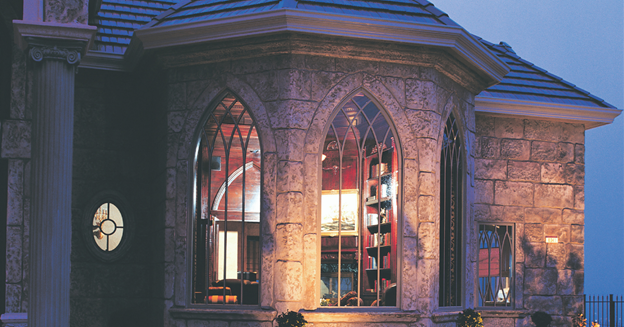
Gothic is a part of classic Canadian architecture. Its historical design can make it challenging to renovate or replicate but choosing the right products is the key to easily matching the style of historic design.
The Gothic Revival has been increasing in popularity in recent years with people rediscovering the beauty of the style that originated in the 1800s. Gothic homes look much like a castle or a church that would be built in the middle ages. Just, much smaller. In fact, it's their size that has been a prime contributor to their popularity in generations that prefer or require smaller square footage.
While they may be small in size, they are big on character. If you saw a Gothic home as a child, you probably thought it looked a bit like a gingerbread house. Even in larger homes, the gingerbread house board and batten that adorns traditional Gothic homes is a style you will likely see mimicked on elevations in newbuild communities.
If you’re looking to infuse a bit of Gothic style into your more traditional home, changing up the doors and the windows are a relatively simple change that will have a huge impact. Installing a transom (the small ‘bonus’ decorative window that goes above or beside your front door) is a quick way to go from cookie-cutter to a hint of Gothic influence. Updating your door to one with the style that’s referred to as ‘frame and plank’ is another easy way to add in a touch of Gothic.
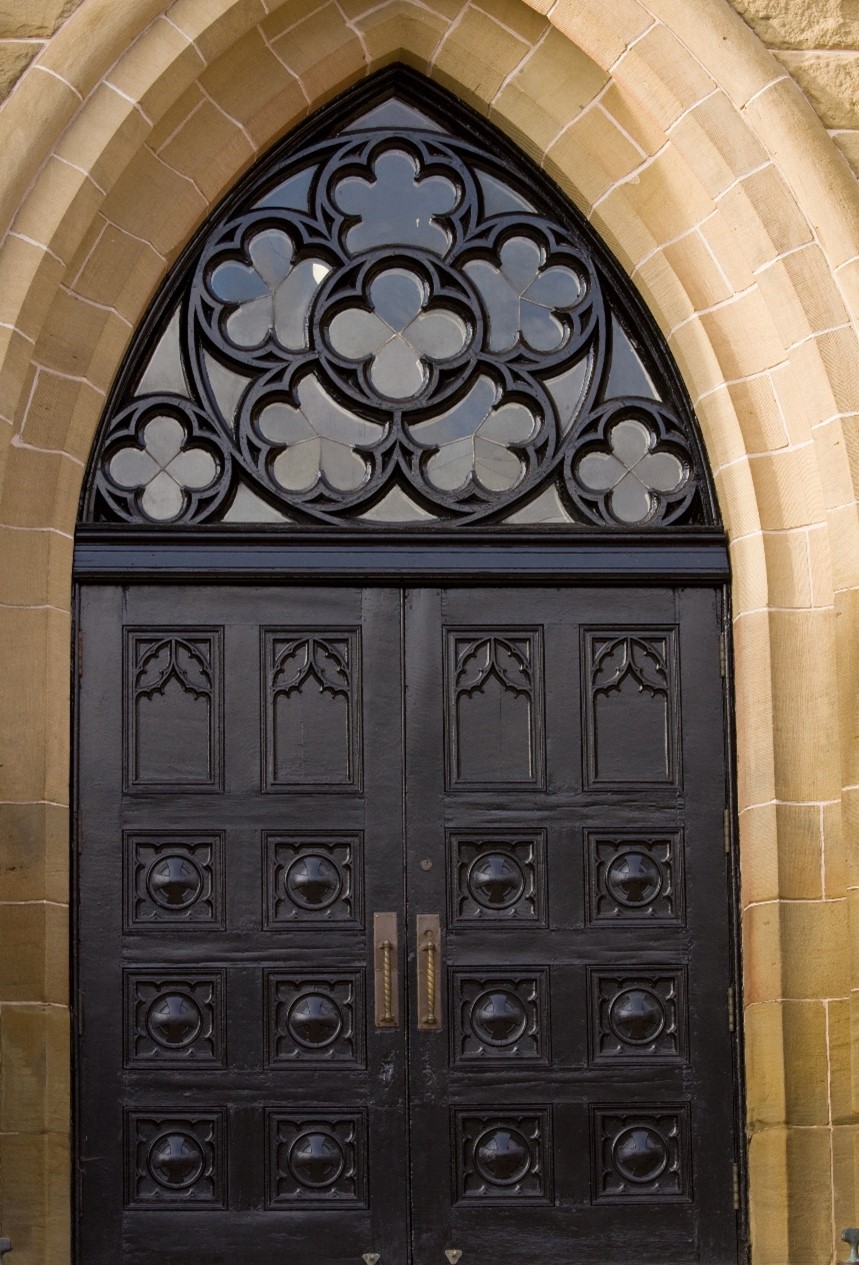
Whether you’re looking to switch up your existing exterior to bring in some historically influenced design, upgrading options on your current Gothic style home, or you’re starting from scratch and building a custom home, there is a lot of character to draw from Gothic-inspired homes.
2. Victorian
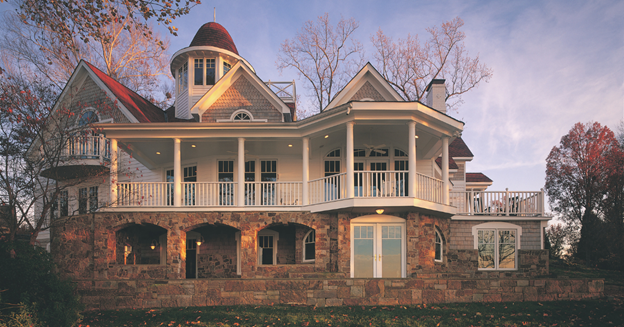 Victorian style is a part of classic Canadian architecture as well.
Victorian style is a part of classic Canadian architecture as well.
If you’ve ever been fortunate enough to walk around the University of Toronto’s downtown campus, you’ll have seen, and maybe even lived in, beautiful, Victorian homes. Characterized by their stature and peaked roofs, this style has had a resurgence in demand amongst new builds and renovations.
Physical structure aside, there are many beautiful elements typical of Victorian façades that contribute to the beauty of these old properties and inspire the new. Most notably, it’s the inclusion of stained glass windows. If you’re looking for Victorian-inspired windows, putting in a large picture window with a beautiful inset of stained-glass will give you the look you’re going for. Some people prefer the rectangular style, stained-glass window but, if you want it to be as authentic looking as possible, the stained glass in the shape of an arch is the best way to do it. Plus, this way you get the benefits of a modern-day window with the curb appeal of the Victorian style.
Much like the windows, doors on Victorian homes are beautifully ornamental, with panels and molding, and glass windows adorned with inset stained glass. Victorian homes of the day boasted not one, but two matching sets of double entry doors, to form a vestibule. Add in giant brass knobs and anyone will feel like they’re walking into a house they recognize as being Victorian inspired.
3. Tudor
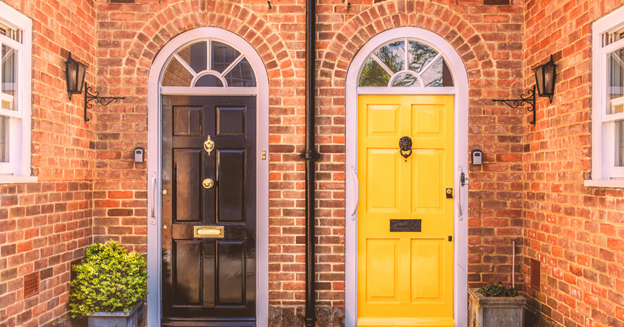
Meandering around old, established Toronto or Vancouver neighborhoods, you are likely to stumble upon many examples of traditional old Tudor homes.
Tudor houses are characterized by their off-center doorways. Always gabled, these entrances offer a unique entry that is set below a steeply pitched roof.
The windows on these homes are often grouped, leaded, and large, and like English cottages, they are also laid out in a diamond pattern. Because both Cottages and Tudors draw direct inspiration from England there are many similarities between the two designs.
Tudor homes tend to have ‘half-timbering,’ meaning part of the home’s exterior was built with both plaster or brick as well as wood; the wooden elements are both structural and decorative.
Doors on these homes are often framed with elaborate detail, with an ode to the era in the form of heavy stones and blocks and a beautiful centre stone (keystone). These doors can be rectangular, but a traditional Tudor will often have an arched doorway to give it the feel of the historical element it is.
Tudor style homes may use multiple window types. The most common is a casement window which usually has multiple windows mulled together. Bay windows also feature prominently on Tudor homes, as well as Transom windows; each type adding to the charm and beauty these houses provide on the exterior and interior of the homes.
 4. Craftsman
4. Craftsman
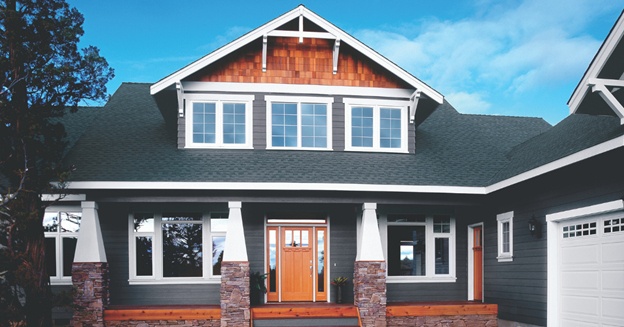
Deemed the image of modernity when it premiered, the Craftsman style aimed to break away from the ornate Victorian style homes; and break away it did! Craftsman is one of those styles you hear talked about on all of the HGTV shows when people in the U.S. are house hunting. We have lots of them here in Canada, too. You’re most likely to see this style of home on the west coast of the country, but that’s not to say that people building custom homes across the rest of Canada aren’t being inspired by the charm of this style.
While the warm weather season is shorter for Canadians, many still want big, beautiful porches in the front to sit on and enjoy while watching and waving to passers-by. This is especially the case as the weather warms and we emerge from months of cold and darkness; the idea of having a big, beautiful porch, typical of Craftsman style homes, to use as outdoor living space is one to which many Canadians look forward.
A hallmark of this style is double-hung windows. To create the patterns typically found with Craftsman style homes, pair your double hung windows with casement and awning windows. The combinations of windows are typically seen in groups of two or three.
The trademark of a Craftsman door is to have glass in the upper third of the door with a decorative piece of trim or molding immediately below – like a small ledge. The glass panes are usually rectangular, but the number of panes can vary; three panes is a very popular choice. Traditional Craftsman doors are typically made of hardwoods like oak, mahogany, or cherry, but some homeowners prefer a mix of modern and traditional and choose materials like fiberglass.

When it comes to the Craftsman, we aren’t talking about one specific style of house. Craftsman homes come in many shapes and sizes, some of which are gaining in popularity in new builds and renos. While they all fall under the Craftsman umbrella, there are four different and distinct styles that are similar in floor plan and general layout, though they vary greatly in size and price. You’ll find the four types of Craftsman styles –Bungalow, Prairie, Mission Revival and Four Square – sprinkled throughout this article as some are a bit of a hybrid with other recognizable Canadian styles.
If you’re looking for Craftsman style color palettes, sticking with brown and green, and undertones of red is true Craftsman inspiration.
Bungalow: The most traditional form of Craftsman home is a bungalow, and it’s what you most likely picture when you hear the term Craftsman style home. Traditionally, these homes are single or single and one-half-storey homes. The extra half a story can come in the form of a side split or a back split, (one storey with steps to a second storey on the side of the home or the back of the home).
A uniquely Craftsman bungalow is commonly characterized by having covered verandas that span the entire front of the property, which is likely why you will find them in more southern parts of the country and along the west coast where people are more able to enjoy outdoor space.
The dormers windows, characteristic of this style, sometimes have an eyebrow window embellishment. These are the beautiful windows that are flat on the bottom and are arched on top. Thankfully, with modern blinds, having these beauties covered on the inside of the home to prevent light seeping through isn’t as much of a challenge as it used to be.
The style of a Craftsman bungalow can hinder the amount of natural light coming into a home, because of the coverage of the roof and the large porches, which add depth outside the window that block sun. Having extra large windows is a great way to make sure you can maximize natural light into the home.
Not quite sold on a Craftsman? Maybe transom windows will sway you. Even if you don’t know the word, you’ve seen many a transom window. They’re those small decorative windows that are horizontal, rectangular, and hung immediately above or beside a larger window, as well as both interior and exterior doors. These windows are purely decorative but they add a truly Craftsman touch. 5. Other architectural styles that became popular with the “Bungalow” style of house
Craftsman bungalows are among the most typical of bungalow styles but there are other types of bungalows that you’ll also see in and around the country.
Prairie Style: This style of home is a sub-category created by renowned American architect Frank Lloyd Wright. His philosophy in design was called ‘organic architecture’ and, for the times (early 20th century), was considered bold.
Prairie style bungalows are characterized by a lower pitched roof (less steep) with a structure that has strong horizontal lines. The Brady Bunch home is a fantastic example of a prairie style bungalow (fact: the 2nd floor of the Brady interior did not exist in the home pictured in the opening sequence of the show. There’s a whole HGTV series about renovating the original to look like the stage, given there was no second floor in the original property!).
Mission Revival: These homes are basically the exact same as Prairie style, with the main difference being that the homes are covered in stucco, rather than the more traditional brick, stone or wooden exteriors.

Four Square: This house is exactly what its name suggests. It is a boxy structure, with two rooms on the bottom, and two on top. While this doesn’t sound like it would fall under the bungalow umbrella, because it’s multi-storied, they are considered as such based on their similar interior layout – just separated by a staircase. 6. Modern
Modern homes have become the most popular style in Canada, and are typically found in big cities like Ottawa and Toronto. Interest in these homes has been growing in popularity in recent years in lock-step with the increasing availability of stock and styles of high-quality materials like marble and expensive woods.
The word ‘modern’ might conjure an image of a highly-customized home with very unique features but don’t let the name fool you. They are built for beauty and are meant to blend perfectly into the surrounding landscape of the property. These houses are characterized by clean lines, open floor plans, and simple proportions. They are not meant to stand out, rather, they are built to beautifully fit in.
West Coast style
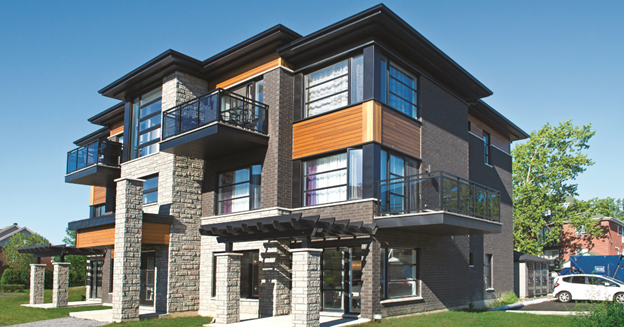
Given that modern homes are built to suit their surroundings, it’s no wonder that the stunning west coast of the country has their own take on the modern home. This style of house is characterized by large flat roofs that have a large overhang to protect the characteristic front porches from the rainy climate. With so much beauty and so much rain, these homes also have large windows to maximize the amount of sunlight and views, no matter where in the house you are.
West Coast style homes also boast an open design with skylights, to bring the outdoor daylight, and evening sky, into the home. These homes speak to the design’s desire to bring the outdoors in and have them work in tandem to bring a unique feeling and style to living among the beautiful elements the west coast provides.
Modern Farmhouse
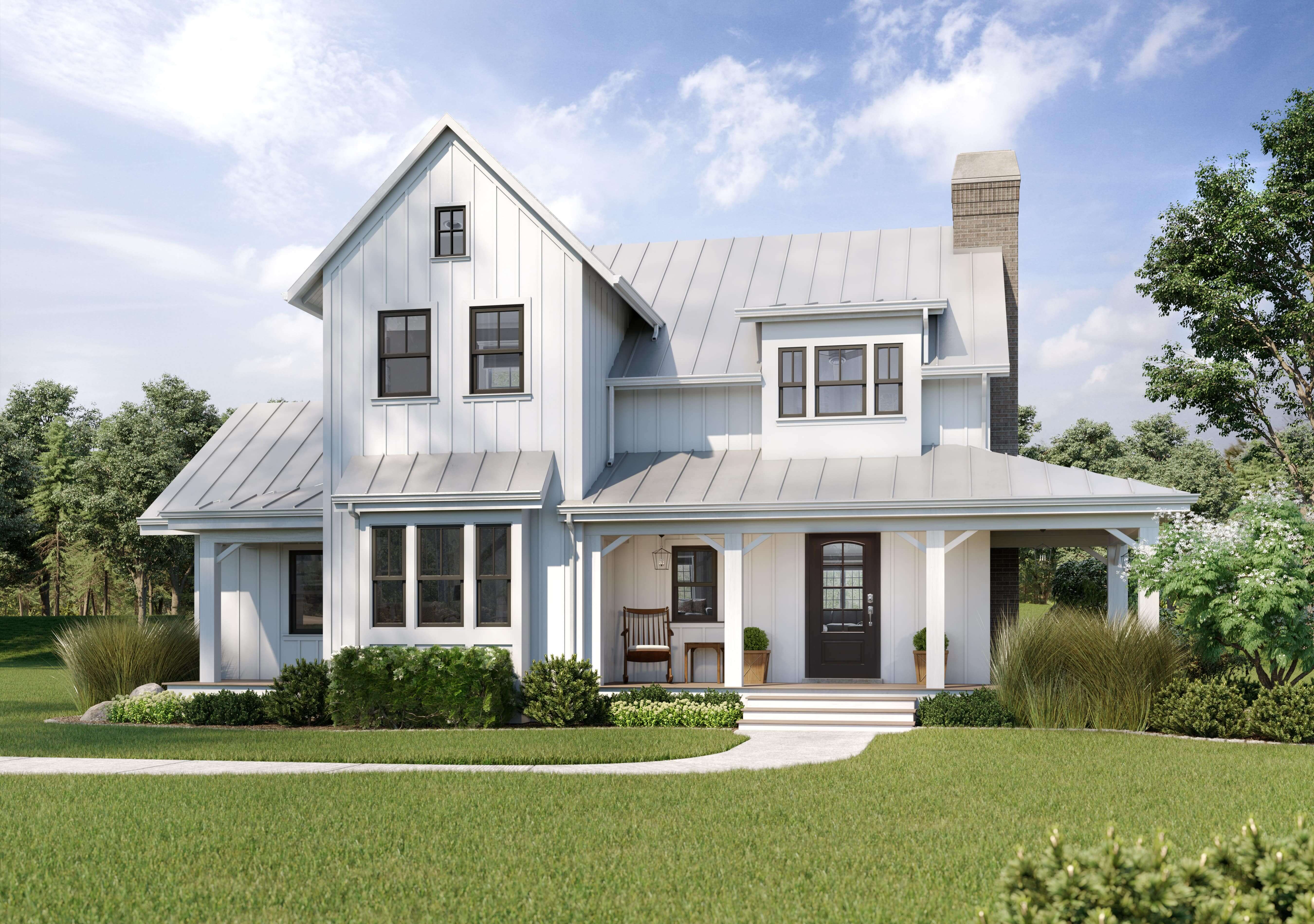
Farmhouses are the more ‘chill’ style of home builds. They are built to be functional. Typically, Farmhouses boast beautiful, reclaimed wood and exposed beams.
It’s common for these homes to have a rectangular foundation, with beautiful large porches and terraces and tall narrow windows.
Farmhouse doors are often made of heavy wood, sometimes with large narrow windows, and other times with dark metal or wooden accents.
One of our favorite elements of Farmhouse style homes, that have been making a major resurgence in rent years, is an interior sliding barn door. Not only are they a lovely visual element, but they are fantastic space savers – especially useful in our modern-day living with minimal sized spaces.
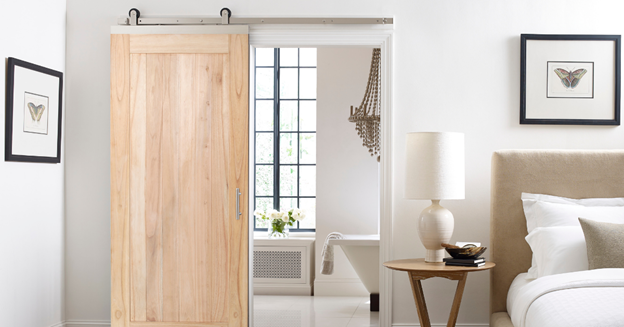 Making it your own
Making it your own
Today, having a modern house doesn’t necessarily mean it looks like it was built yesterday. Taking inspiration from traditional homes, and either using elements that pay homage to, or entire façades that replicate older styles brings character and beauty to homes.
Updating the esthetic and functionality of your home increases resale value; making updates to your windows and doors something that should top your list of Return on Investment reno projects.
JELD-WEN has long been a part of helping Canadians who are built to renovate find the right products to suit their preferred home style. With over 60 years of experience and innovative product offering, if there is a style of window or door you are looking for, you can count on JELD-WEN to help bring your vision to life.
Explore Related Posts












